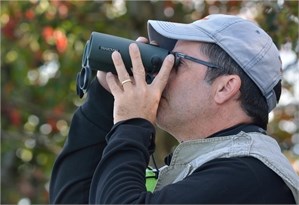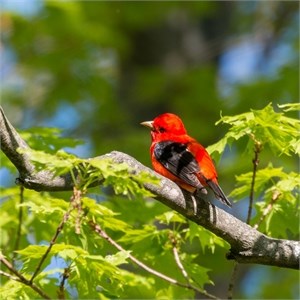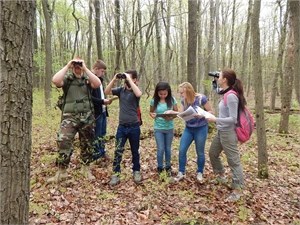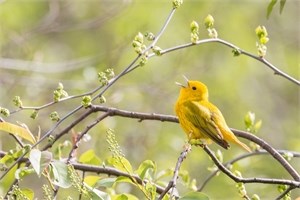Breeding Bird Census: Documenting our Forest Symphony
Posted on May 28, 2019 in Education

The sounds of spring are potently defined by the vocalizations of birds. In Rachel Carson’s impactful book Silent Spring, she referenced this underrated truism, and illustrated the alarming reality of a world devoid of birdsong to mobilize the public and call attention to harmful pesticides threatening bird populations across the nation.
Take a moment and envision a world without singing birds. Think of how different each morning would feel, how much dimmer each sunset would seem without the accompanying chorus of whistles, hoots, chortles, coos, and melodic serenades. The sheer variety of these sounds is astonishing, and the individuality of each bird’s voice is what allows them to find each other, woo each other, and ultimately claim their territory at the beginning of each breeding season. As it turns out, their vocal theatrics serve as a helpful indicator for scientists interested in monitoring the health of bird populations as a whole.
The global conservation community has many research tools that allow for such monitoring. At Hawk Mountain Sanctuary, we participate in one called the Breeding Bird Census (BBC) that is conducted throughout North America for the purpose of amassing records of species during the breeding season that allow scientists to keep an eye out for shifts in population trends. Hawk Mountain is proud to have the oldest, continuous BBC site in Pennsylvania, having conducted counts since 1982.
Each year our research biologist David Barber submits data from Hawk Mountain Sanctuary by first documenting resident birds at the end of April, and then monitoring the progression of the breeding season by walking ten transects at Owl’s Head and River of Rocks, from May 15th through June 30th. David conducts surveys called spot mapping, for which he notates the approximate location and species of singing and calling birds. His efforts help document the phenology, or timing, of returning migrants as they establish breeding territories. This type of consistent, annual monitoring is important because it allows us to compare our observations with other sites around the Eastern United States who are welcoming home similar species. We can then engage in scientific conversation about patterns region-wide, and help inform conservation management decisions, scientific research questions, and the general public.
Another benefit of the BBC is that population trends of breeding birds can indicate overall forest health. For example, scarlet tanagers typically require continuous tracks of healthy forest for their breeding sites. Therefore, if we notice declines in the numbers of breeding tanagers, there could be an issue of fragmentation or other factors preventing these lovely songsters from utilizing the same forest in consecutive years. The sooner the decrease in territories is noticed, the better, and with proactive monitoring programs like BBC there is a higher likelihood of understanding the interconnectedness of a habitat, and the effects of change on its inhabitants before it is too late.

Since the beginning of BBC at Hawk Mountain, we have seen an increase in the number of territories for rose-breasted grosbeaks, scarlet tanagers, and ovenbirds. Many species have remained steady, though we have also noticed declines in populations of tufted titmice and black-capped chickadees. There are also examples of birds that are doing well on our plots but have suffered a decline state-wide such as the Eastern wood-peewee. Each year David leads the charge in documenting these trends on Sanctuary property, not only for the above-mentioned species but for many more. He cherishes the early mornings with the acoustic repertoire of the species he’s come to know so well.
While the recognition of over 100 bird songs and calls has become second nature for David, this level of memorization can seem like a daunting task for non-birders or beginners. However, there are many citizen scientists and migration enthusiasts participating in bird monitoring surveys who have, over time, learned tricks of the trade. It truly does become easier with practice.

This was a key part of our introduction when we traveled to Hamburg Area High School this spring to teach Cheryl Bucheit’s environmental science class how to identify 21 species by song and sight. Cheryl has been bringing her students to participate in the BBC at Hawk Mountain for three years as a way of illuminating for them the world of birds, and to introduce them to all Hawk Mountain has to offer as their backyard conservation organization. This year, the Sanctuary’s Director of Education Erin Brown coordinated a visit to the school during which leadership trainee Zoey Greenberg gave a presentation orienting the students to census protocol, and playing the songs of those species the students would most likely hear during their survey in May. They were also given mnemonics to help them memorize birdsongs such as the demanding voice of the ovenbird, which appropriately sounds a lot like “TEACHER TEACHER TEACHER!!!” (Click here to listen!)
When asked to comment on the relevance of this experience for her students, Cheryl says that their excitement and delight in recognizing birds on their own is palpable. She recalls students returning from weekend trips with pride, recounting the species they were able to identify for their families. Baseball players come back from practice announcing local species they hear out on the field. Many young people remain unaware that birds can become a hobby, let alone a career. The benefit of unveiling this feathered world for young, energetic science students is priceless, and the BBC is an appropriate initiation into the “why it matters” portion of Hawk Mountain’s mission. We educate and conduct science on birds of prey because we believe they deserve a place in our world. If we want a broader base of young folks to believe the same, then providing them with the experiential process of exploring the forest through the eyes of birds will certainly help them connect with our mission into adulthood.

The magic of spring is tangible when you are standing in the middle of forest teeming with the hustle and bustle of courtship, territorial displays, and nest construction. To us, the sounds are often relaxing, though for many of these feathered male denizens, there is a lot to do come springtime, and not much time to do it. We encourage any readers who have not yet done so, to take a few moments and step outside into this complex symphony. Listen for your backyard breeders as they sing their song for all the yard, all the forest, all the world, and you, to hear.